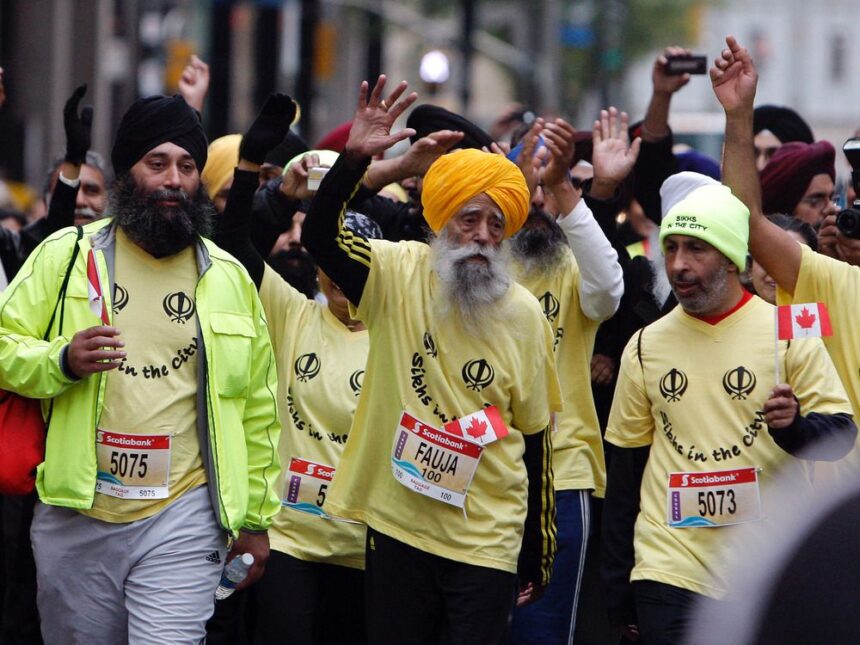The cold winter air hung over the modest brick bungalow in Ilford, East London where Fauja Singh had spent his final years. In the front room, family photos chronicled an extraordinary life that began in Punjab in 1911 and stretched across three centuries. Among them, images of Singh crossing finish lines in his signature yellow turban, defying conventional understanding of human aging and endurance.
On April 15, 2024, the man known as the “Turbaned Tornado” took his final breath at 114 years old, days after being struck by a vehicle while on his daily walk near his home. His death closed a remarkable chapter in marathon history that began when most people are well into retirement.
“My grandfather taught us that age is just a number,” his granddaughter Mindu Kaur told me by phone, her voice steady despite her grief. “He always said the body can endure what the mind believes is possible.”
Singh’s journey into running began at 89 after moving to England following his wife’s death. What started as therapy for depression transformed into an astonishing athletic career that saw him complete his first marathon at 89 and his last at 101. In 2011, at the Toronto Waterfront Marathon, he became the first centenarian to complete a marathon, finishing in 8 hours, 25 minutes and 16 seconds.
The Toronto running community embraced Singh as one of their own. Race director Alan Brookes, who first invited Singh to Canada, described him as “a beacon of light and inspiration” who transformed their event.
“When Fauja ran with us in 2011, something magical happened,” Brookes recalled. “Thousands lined the course just to witness this extraordinary human spirit in action.”
Though Guinness World Records never officially recognized his age accomplishment due to the lack of a birth certificate (common for his generation in rural Punjab), the running community never doubted his achievement.
Singh’s life spanned the dissolution of the British Raj, two World Wars, the partition of India, and the digital revolution. Born to farmers in Punjab in 1911, he didn’t walk until age five due to weakness in his legs. The irony wasn’t lost on him that those same legs would carry him through 10 marathons after age 89.
Dr. Melissa Witkowski, a gerontologist at the University of British Columbia who studies exceptional aging, points to Singh as a powerful counterexample to our cultural assumptions about aging.
“What’s remarkable about Fauja Singh isn’t just his longevity, but his quality of life,” Witkowski explained. “His choice to begin an intense physical practice in his ninth decade challenges everything we thought we knew about the capabilities of the aging human body.”
Singh’s training regimen was deceptively simple: daily walks, light running, and a vegetarian diet rich in curry and tea. He avoided alcohol and smoking his entire life and maintained deep connections to his Sikh faith and community.
In Toronto’s Sikh community, Singh was revered not just for his athletic feats but for his humility and service. He raised nearly $500,000 for various charities through his running, including Sikh humanitarian organization Khalsa Aid and several hospitals in the UK and India.
Balpreet Singh (no relation), legal counsel for the World Sikh Organization of Canada, emphasized the broader impact of Fauja’s visibility. “For many young Sikhs growing up in the post-9/11 era when turbans were often viewed with suspicion, seeing Fauja celebrated worldwide provided a powerful counter-narrative. He showed that the turban represents resilience, determination and service.”
In his later years, Singh published an autobiography, “Turbaned Tornado,” with all proceeds going to charity. He carried the Olympic torch during the 2012 London Games and received the British Empire Medal for services to sport and charity in 2015.
I met Singh in 2018 when he visited Vancouver for a community event. Though his English was limited and he spoke primarily through a translator, his charisma transcended language. His weathered hands, with knuckles swollen from decades of farming and then running, gestured animatedly as he described the feeling of crossing a finish line.
“When I run, I talk to God,” he told me through his translator. “My feet become my prayer.”
His death has prompted tributes from around the world, including from Kenyan marathon legend Eliud Kipchoge, who called Singh “the embodiment of endurance in its purest form” in a statement on social media.
Singh’s funeral will be held in London next week, with memorial runs planned in Toronto, Vancouver, New York, and Delhi. His family has requested donations to Khalsa Aid instead of flowers.
Perhaps Singh’s greatest legacy lies not in record books but in how he transformed cultural perceptions of aging. In a society that often isolates and diminishes its elderly, Singh offered a radically different vision—one where our later years can be a time of growth, contribution, and even athletic achievement.
As night falls over Toronto’s lakeshore path where Singh once made history, runners of all ages continue to trace his footsteps. Among them are many who wouldn’t be there if not for the centenarian who showed that it’s never too late to start.






